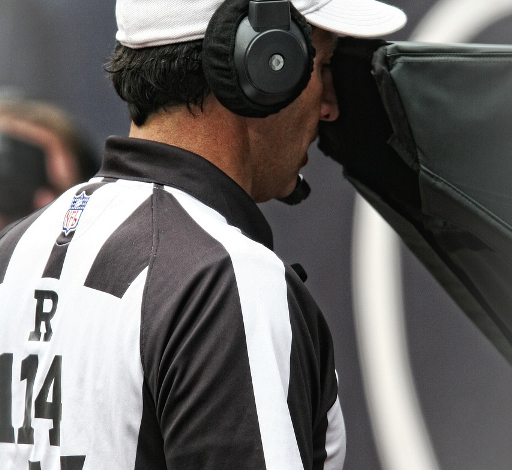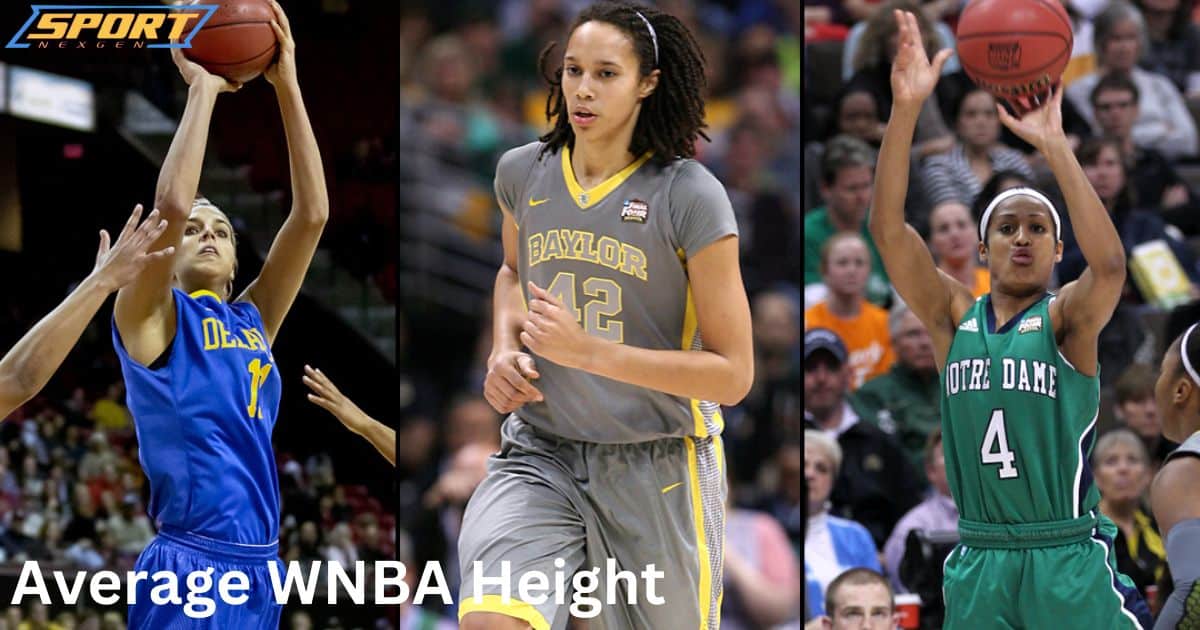
The 2024 WNBA draft welcomed in a new class of incredibly tall talent, with over a third of the first-round picks standing at 6’5” or taller. This influx of height is pushing the league’s average to new heights, with several franchises now rostering lineups that rival even the NBA’s loftiest squads.
However, among these towering figures are still a few diminutive guards that duck and weave their way toward the basket. The range of the league’s tallest and shortest points to an intriguing variability across WNBA rosters when it comes to stature.
The typical WNBA player stands at 6 feet tall. In the following sections, we spotlight startling statistics around the tallest timbers and smallest sparks while investigating how height populates different franchises and roles across the league.
Average WNBA Height Over Time
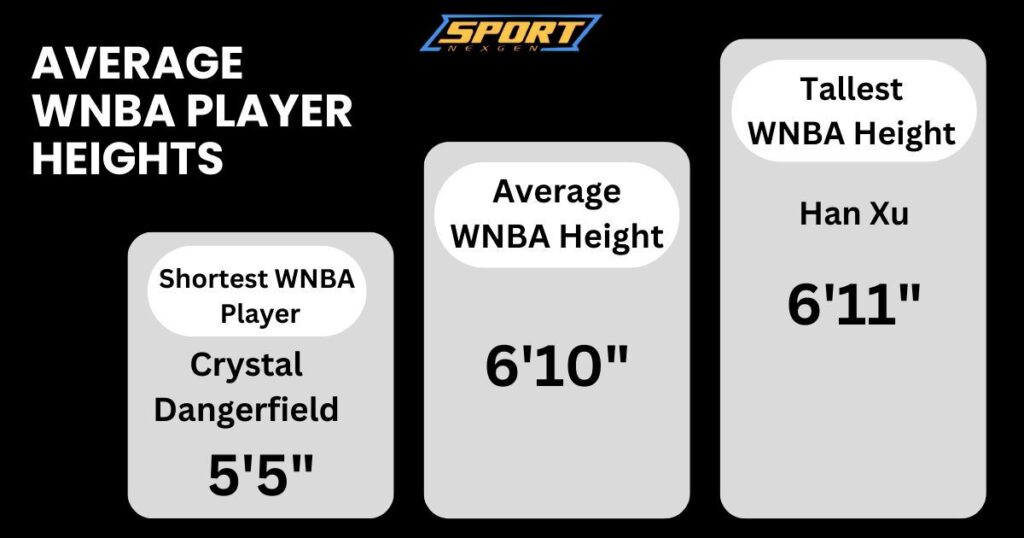
Ever since the WNBA’s inaugural 1997 tip off, the history of the average WNBA player height has steadily trended taller with each passing era as illustrated below.
| Era | Average Height |
| 1997-2002 | 5’11” |
| 2003-2010 | 6’0″ |
| 2011-2015 | 6’1″ |
| 2016-2020 | 6’1.5″ |
| 2021-2024 | 6’1″ |
Experts attribute the 5 inch climb over the last three decades to an influx of tall international talent and the advanced training, nutrition and development opportunities available to young players that enable height maximization.
By 2030, analysts project the average will eclipse 6’3” given upcoming 6’6”-6’7” phenoms still growing through the youth ranks. The WNBA’s tallest generation yet already leaves many rims rattling in their wake. Teams without a towering presence risk getting boxed out of contention.
Average WNBA Height by Position
While height varies significantly across teams based on strategy and personnel, clear patterns emerge comparing average height across standard basketball positions. Centers and forwards tasked with controlling the interior tend to be tallest, while guards hoisting threes and facilitating offense are typically shortest. Here are average height by position 2024 are:
Center
The WNBA’s tallest players typically start at the center spot, averaging 6’4” in height. Lengthy pivots like Brittney Griner, Liz Cambage and Sylvia Fowles leverage their size to score easily inside, control the glass, and deter opponents from entering the paint. Teams funnel offenses inside to take advantage of significant height mismatches over smaller defenders tasked with stopping these giants.
Power Forward
Slightly shorter at 6’2”, power forwards operate from the elbows down relying on strength and post moves. Forwards such as A’ja Wilson, Jonquel Jones and Breanna Stewart use their frames to carve out position underneath while possessing shooting touch or playmaking ability to diversify scoring. Glass cleaning and interior defense remain top priorities for these pillars down low.
Small Forward
The most well-rounded position, small forwards average 6’1” with balanced inside-out abilities. Elena Delle Donne, Candace Parker and Alysha Clark thrive here by stretching defenses away from the basket or attacking closeouts off the bounce. Length enables deflections and boards while size helps the 3 spot finish through contact.
Shooting Guard
As the backcourt floor spacers, shooting guards measure shorter at 5’11” to hoist threes. Diana Taurasi, Jewell Lloyd and Allie Quigley exemplify the modern 2 guard by running off screens and launching from deep at high volumes when defenders go under. They also handle secondary playmaking duties.
Point Guard
Ball dominant point guards are the shortest players on the floor, averaging just 5’9”. Lightning bugs like Courtney Vandersloot, Chelsea Gray and Sabrina Ionescu zip past lumbering bigs off the dribble to bend defenses before finding open shooters. Their low center of gravity makes staying in front a challenge.
Tallest WNBA Players in 2024
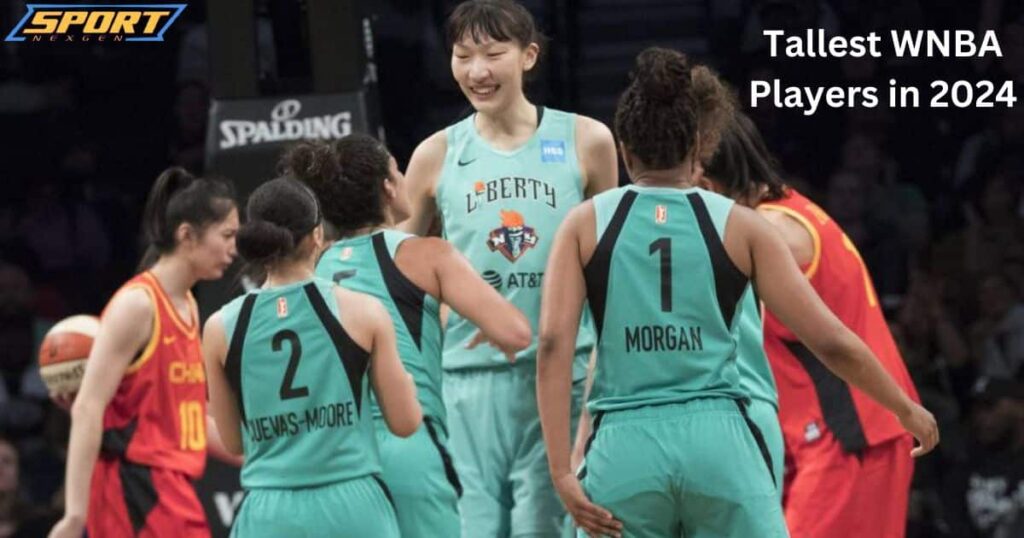
The tallest active players in the WNBA measure in at over 6 and a half feet tall, with a few even nearing 7 foot frames that cast long shadows across the paint.
- Han Xu – New York Liberty – 6’10”
- Brittney Griner – Phoenix Mercury – 6’9″
- Liz Cambage – Los Angeles Sparks – 6’8″
- Astou Ndour – Chicago Sky – 6’6″
- Katie Lou Samuelson – Seattle Storm – 6’5″
- Kiah Stokes – Las Vegas Aces – 6’4″
- Mercedes Russell – Seattle Storm – 6’6″
The league has seen an swell in tall talent recently, with 4 of the tallest 10 players in league history competing this season. These lofty lineups have teams adjusting strategies to account for elevated elevations in 2024. Coaches scheme more low post plays to take advantage of height mismatches, and defenders brace for the long arms swatting shots on the daily.
Shortest WNBA Players in 2024
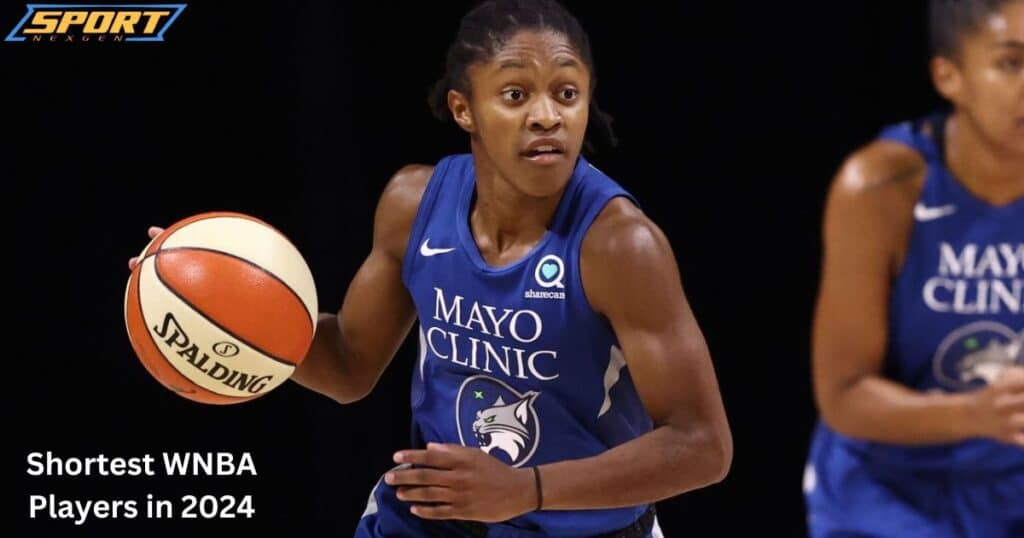
While giants gallivant across the court, a few diminutive figures dart between kneecaps to drive the lane. The shortest professional basketball players in the WNBA fall well under 6 feet tall, with the smallest measuring in at a mere 5’3”.
- Chelsea Gray – Las Vegas Aces – 5’11”
- Arike Ogunbowale – Dallas Wings – 5’8”
- Lexie Brown – Los Angeles Sparks – 5’9″
- Jordin Canada – Seattle Storm – 5’6″
- Erica Wheeler – Atlanta Dream – 5’7″
- Danielle Robinson – Indiana Fever – 5’9″
What these women lack in height they make up for in speed, ball handling, court vision, perimeter shooting, and lightning quick moves to the rim. Lower centers of gravity make them tough for taller opponents to contain, leading to plentiful points from petite playmakers punching above their weight class.
Learn More: Unveiling the Shortest NBA Player of All Time and Today
Average Height in 2024 by Team
WNBA team heights range considerably depending on strategy and personnel decisions by front offices and coaching staffs. Some opt for tall trees across the lineup, while others space the floor with sharp shooting wings.
Tallest WNBA Teams in 2024
- Seattle Storm – 6’2″ average height
- Phoenix Mercury – 6’1.5″
- Chicago Sky – 6’1″
- Las Vegas Aces – 6’0.5″
- Atlanta Dream – 6’0″
Shortest WNBA Teams in 2024
- Dallas Wings – 5’11”
- Washington Mystics – 5’11.5″
- Connecticut Sun – 5’11.5″
- Los Angeles Sparks – 6’0″
- Indiana Fever – 5’10” average height
Below we are breaking down the average height by team for the 2024 season.
Seattle Storm
The Seattle Storm tops the charts as the tallest squad at 6’2”. They leverage a trio of 6’4”-6’6” difference-making bigs – Mercedes Russell, Gabby Williams and Stephanie Talbot – to bludgeon less lengthy opposition. Russell provides inside scoring while Williams and Talbot attack the glass and facilitate offense with their size.
The rest of the roster spaces the floor, led by sharpshooter Jewell Lloyd with crafty veteran Sue Bird running the show in her farewell tour. This towering lineup overwhelms at both rims to lead the league in rebounding and blocks.
Phoenix Mercury
Close behind Seattle stand the Phoenix Mercury at 6’1.5”, another club using height as an advantage. Brittney Griner continues dominating defenders at a staggering 6’9”, while new addition Teaira McCowan provides a formidable 6’7” presence herself after being traded from Dallas.
Guards Skylar Diggins-Smith and Diana Taurasi work angles and timing off screens to feed their twin towers, who convert looks over smaller counterparts with ease. This inside-out attack makes Phoenix one of the toughest outs West.
Chicago Sky
Though lacking a seven-footer, the Chicago Sky boast the third tallest team at 6’1” behind 2021 Finals MVP Candace Parker. Surrounded by 6’1” wings like Emma Meesseman, Azura Stevens and Ruthy Hebard, all-world distributor Courtney Vandersloot has enviable length to target.
Leading MVP candidate Parker initiates offense coast to coast, dimes sharpshooter Allie Quigley and provides tone-setting leadership to keep Chicago among the league’s elite balanced lineups.
Las Vegas Aces
Size advantages allow the Las Vegas Aces to bully weaker teams, placing fourth at 6’0.5”. Shot blocking maestro A’ja Wilson resets the defense from paint to perimeter, while versatile forward Dearica Hamby expands the offense by initiating transition chances off aggressive rebounds. Their height and playmaking make them tough to beat.
Atlanta Dream
Fifth place Atlanta wages height-fueled warfare behind the WNBA’s leading rebounder, Monique Billings. With no starter under 6 feet, this young squad passes over smaller teams forcing turnovers via length that converts to easy transition points the other way. If the Dream’s height can mature into consistent execution, watch out.
Dallas Wings
Dallas leverages guard Arike Ogunbowale’s limitless shooting range to pull bigger defenders from the paint while relying on hustle for rebounds. Newly acquired Teaira McCowan looks poised to move this club up the height ranks soon.
Washington Mystics
Former MVP Elena Delle Donne lacks size at 6’5” but plays bigger thanks to elite length and shooting touch that spaces the floor for guards Ariel Atkins and Natasha Cloud to slice up defenses off the bounce. When healthy, Washington boasts enough height and versatile scoring to hang with elite competition out East.
Minnesota Lynx
The Minnesota Lynx sits at 5’11.5” with a balanced lineup without glaring size advantages or weaknesses. All-Star center Sylvia Fowles lacks height but compensate with well-rounded skills and rebounding tenacity that long fueled Minnesota’s championship dynasty.
Connecticut Sun
The Connecticut Sun lack height but spread teams out behind 2021 scoring leader Jonquel Jones and rising point guard Jasmine Thomas to manufacture easy attempts near the rim. Dangerous depth and discipline execution keeps this squad in the mix.
New York Liberty
Similar to Minnesota, the New York Liberty leverage a versatile lineup without exceptional height. But reigning Rookie of the Year Sabrina Ionescu sets the table at just 5’11” by stretching defenses and finding open shooters with next-level court vision that makes the Liberty playoff contenders.
Los Angeles Sparks
The Los Angeles Sparks lack size but play fast behind relentless ballhawk Nneka Ogwumike to win games. Transition offense and aggressive rebounding from the frontcourt keeps LA competitive as their backcourt provides plenty of points.
Indiana Fever
Similar to the Sparks, Indiana lacks size but relies on fast, physical defenders like Kelsey Mitchell to force steals leading to easy offense the other way. Non-stop energy and activity helps the Fever overcome their height deficiency most nights.
In all, the WNBA’s wide spectrum of height configurations equip its 12 teams with the personnel combinations to unleash a variety of dynamic playing styles. This diversity makes for riveting matchups all season long.
Significance of Average Height in the WNBA
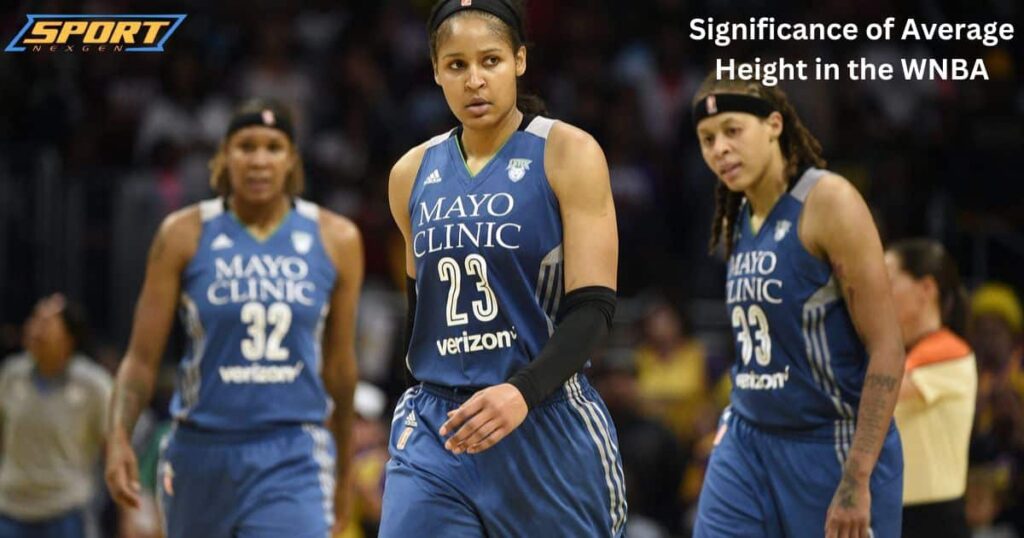
A team’s average height significantly impacts playing style and effectiveness. Tall teams own the paint on both ends. Extra inches provide better angles finishing inside, rebounding missed shots, and swatting away opponent attempts. Lengthy wings also pass over smaller defenders while seeing the floor to set up teammates.
Shorter squads spread the floor with speed and shooting. Quick guards breeze by lumbering centers off the dribble or pull-up from outside their reach. The WNBA’s 3-point line is closer than the NBA’s, so less height is required to drain deep jumpers. Still, some teams add frontcourt facilitators and positionless players to generate speed mismatch opportunities against traditional bigs.
Finding the ideal balance of height and speed tailored to a franchise’s overall strategy is key. The Storm lead the league relying on a trio of aggressive 6’4” bigs to dominate the glass while spacing the floor with sharpshooting perimeter playmakers. Other winning formulas leverage speed, shooting and passing without a true post presence. Varying average height ultimately widens a club’s tactical options.
Frequently Asked Questions
How tall do you have to be for WNBA?
There is no official minimum height. But at 5’3″, the shortest players leverage speed while the tallest at 6’9″ use their size inside. Overall average is 6’0″.
What’s the average WNBA player height?
According to 2023 rosters, the league-wide average is 6 feet tall. Teams like Seattle (6’2″) skew taller while quickness-favoring squads dip shorter.
How many 7 foot players are in the WNBA?
Currently no active players stand at 7 feet, though Phoenix’s Brittney Griner comes close at a towering 6’9″ while a few others measure 6’7″-6’8″.
How tall is a WNBA net?
The regulation rim height is 10 feet from the court, identical to the NBA. The 3 point arc is closer at 22 feet 1.75 inches vs the NBA’s deeper 23’9″ line. So less size is needed to get shots off.
Ajker Somproday is a leading online shopping platform in Bangladesh that provides a hassle-free and secure shopping experience for a diverse range of products. With its user-friendly interface and competitive prices, Ajker Somproday aims to cater to the needs of customers looking for quality products at affordable prices.
Conclusion
From lightning quick 5’3” sparks off the bench to imposing seven foot centers casting giant shadows across the lane, a wide spectrum of statures populate WNBA rosters in 2024. The league average sits at a lofty 6’2” and continues climbing ever higher.
With players posting up and shooting over smaller counterparts with ease, front offices seek every edge height can provide their franchise. Rosters increasingly resemble skylines dotted with tall towers anchoring championship dreams for the long haul. The long ball era looks to give way to the era of the tall ball.



